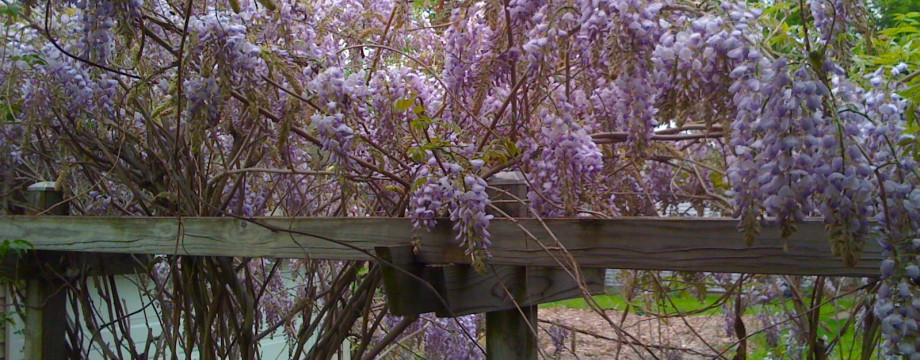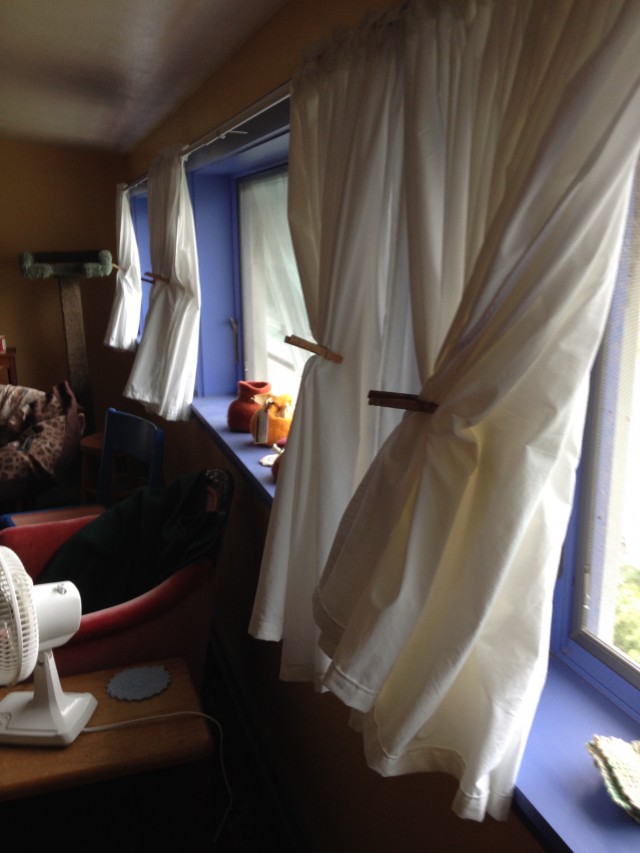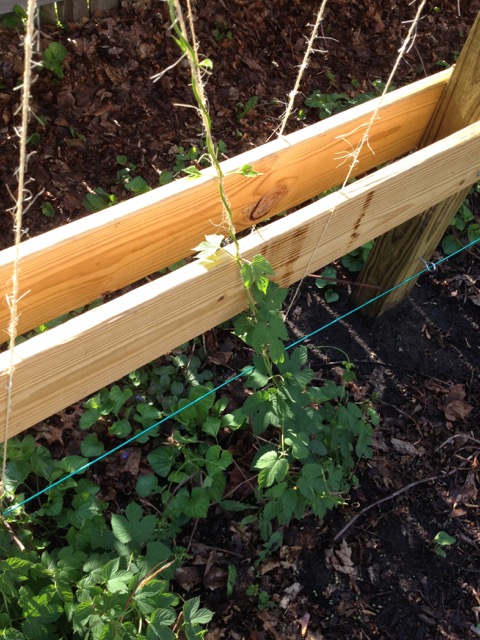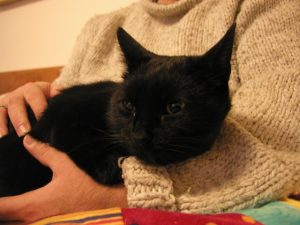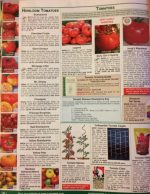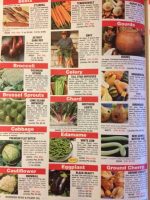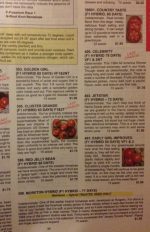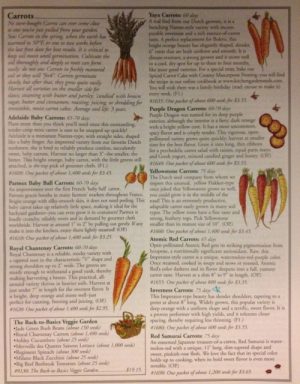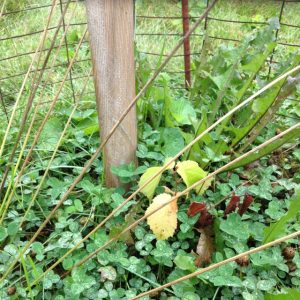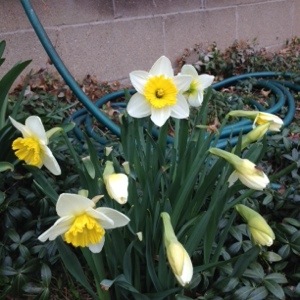Some things gained and some things lost: the dilemma of the second vehicle
 Last year I learned that I should never say “never”. A year ago, I bought a second vehicle. For all my adult life I was fiercely determined to either have no vehicle or to only own one vehicle. I didn’t even get a drivers license until I was 26 or 27. I lived in cities where I could walk or take public transportation to all the places I wanted to go. When we moved to Goshen, we chose to live in a location where both of us could walk to work, so that we would never need a second vehicle.
Last year I learned that I should never say “never”. A year ago, I bought a second vehicle. For all my adult life I was fiercely determined to either have no vehicle or to only own one vehicle. I didn’t even get a drivers license until I was 26 or 27. I lived in cities where I could walk or take public transportation to all the places I wanted to go. When we moved to Goshen, we chose to live in a location where both of us could walk to work, so that we would never need a second vehicle.
But, when I saw a pickup truck for sale last March, it did not take me long to send an email expressing my interest. Within days I was the owner of a second vehicle.
We used to own a small pickup truck, a Chevy S-10. It was our only vehicle, perfect for living in the semi-rural neighborhood of north Vashon Island in Washington State. We used it for hauling all sorts of things – furniture, mulch, compost, manure, wood. We spent nights in the bed of the truck, hoping to see meteor showers in August and November. We got a cap for it and used it for camping. On the way to Burning Man, our 17 year old pickup truck, packed full of all the gear we would need for a week in the desert, catastrophically died in a small town in Nebraska. We hastily replaced it with a Chevy Suburban, the only vehicle we could quickly find that was large enough to fit all the stuff that had been packed in the S-10. Though the Suburban was disturbingly appealing (it really did ride well) we could not see keeping it once we arrived back home. A huge gas–guzzling vehicle didn’t fit with our self–image of nature loving, small–carbon–footprint type of people. So, after only a month, we traded the behemoth Suburban in for a cute and tiny Smart Car.
Then I decided to quit my teaching job and become a small–scale urban farmer. I had romantic, though totally unrealistic, notions of doing all that I needed to do using only the tiny car and my bicycle outfitted with an Amish cart. After doing restaurant deliveries for Clay Bottom farm, I knew the Smart Car fit a remarkable amount of produce. I also already knew that I could haul quite a lot in my bicycle cart. So I happily told people that I had plans of, one day, having a bicycle–delivered CSA program in Goshen.
But I had reservations. Would a bale of straw even fit in my cart? And, even if one bale of straw would fit into the cart, how many trips to Tractor Supply Company would I need to do every fall to get sufficient straw for winter mulching.
Then I saw the ad – a used Toyota Tacoma – another small truck. I knew how useful a little truck could be. Realism won over romanticism and all determination to remain a one–vehicle household disappeared within hours.
As expected, the truck has proven its usefulness. I transported long pieces of pipe for the greenhouse project. I weighed it down with duck manure for the garden. I fit many bales of straw into the spacious bed of the truck. We brought home twelve foot long fence posts to build a hops trellis.
Along with the gains of convenience that a second vehicle affords, there are also some losses.
I’ve lost my self-righteousness. That is a good thing.
But I’m not so sure about some of the other losses.
I’ve lost some creativity. In pre-pickup truck days, I had to work out inventive ways of hauling things. I had to solve a packing problem in order to fit six wooden chairs in the Smart Car to take to the resale shop. I had figure out how to strap a tall bookcase in the cart so it wouldn’t topple over when I was taking it to my mom’s place. As yet, it hasn’t taken much ingenuity to load things into the truck, though strapping in twelve foot long fence posts did require some creative use of bungee cords.
I’ve lost some spirit of adventure. A cart loaded up with 120 lbs of compost still obeys the laws of physics, in particular the law that states that an object in motion tends to keep moving. My heart skipped a beat when that cart pushed my bicycle into an intersection at a stop light. Another time my bicycle–cart combination threatened to jack–knife when I brought home eight short fence posts. I don’t get the same adrenaline rush now when I put fenceposts and bags of compost into the back of the pickup truck.
I’ve lost some of the need for negotiation and compromise. With a household of two and only one vehicle, we sometimes needed to be in two places at the same time. Figuring out how we would accomplish that brought about many discussions. Could we put off one of the trips? Was there an alternate mode of transportation we could use? Could we somehow combine our two trips? We used to be more intentional about the trips we made and when we made them. But now, we don’t need to negotiate. We usually just go our separate ways in separate vehicles.
I’ve lost some built–in exercise. Sometimes, when we were traveling in opposite directions, I opted to go by bicycle. I still walk and bicycle a lot, but it is way too easy, especially in less than ideal weather, to instead choose to take the second vehicle. So I’m not getting as much exercise as I used to get.
I think that I am glad I have the truck. But sometimes I’m not so sure. Maybe in some other universe, I kept to my resolve and continued with an adventure of urban farming with a tiny car and a bicycle-cart. But not here and not now.
Sticky Experiments in Extracting Honey
My bees didn’t make it through the winter. With the warmer weather in the last couple of weeks, I should have seen some activity outside my hive, but it remained eerily quiet. So finally, on a warm day, I opened up the hive. All I saw were dead bees. With sad thoughts, I cleaned out the hive and removed the combs that still had honey.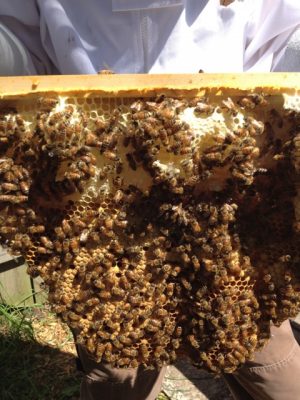
I have a top bar hive. My bees build comb that hang down from wooden bars in wonderful organic shapes. With this type of hive, in order to get honey, I have to cut the combs off the bars, crush the comb, and somehow separate the honey from the wax.
The last time I tried to extract honey from my crushed combs, I used the double boiler method. The idea was to completely melt the wax. Then, when the wax–honey concoction cooled, the wax would rise to the surface and be able to be skimmed off.
I didn’t have a double boiler, so I had to improvise. Crushed wax and honey went into a pot that went into another pot filled with water. Then the two pot contraption went on the stove. I stirred the mixture, scooping the wax that rose to the surface with a spoon and dumping it into a bowl. Once everything was liquified, I poured the honey–wax solution through a sieve into another bowl. Since there still looked like there were particles in the strained mixture, I tried melting everything again and straining through cheesecloth. Eventually I managed to get honey into mason jars. Much as I tried to skim off the wax, it managed to get into the mason jars as well. Consequently, when the honey mixture cooled in the jars, the wax solidified to form thick wax caps at the top of the jars. By the end of the whole process, I was left with a messy, sticky kitchen filled with messy, sticky pots, bowls, utensils, and a sieve that would never be the same.
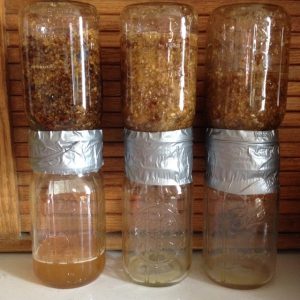 So this year, I wanted to try something less complicated and less sticky. I found instructions on the internet for a simple filtering system using two mason jars. I cut the combs off the bars, crushed the honeycomb in a bowl and put the crushed comb into a wide mouth quart mason jar. The instructions recommended using a screen of some sort, but, having no screen, I draped cheesecloth over a second, empty, wide mouth mason jar and screwed on the metal band to hold the cheese cloth in place. I duct taped the two mason jars together, metal band to metal band, flipped the pair over, and let the honey drip through.
So this year, I wanted to try something less complicated and less sticky. I found instructions on the internet for a simple filtering system using two mason jars. I cut the combs off the bars, crushed the honeycomb in a bowl and put the crushed comb into a wide mouth quart mason jar. The instructions recommended using a screen of some sort, but, having no screen, I draped cheesecloth over a second, empty, wide mouth mason jar and screwed on the metal band to hold the cheese cloth in place. I duct taped the two mason jars together, metal band to metal band, flipped the pair over, and let the honey drip through.
This was less complicated, but still sticky. Honey still managed to find its way through the duct tape to leak onto the outside of the jars and onto the counter.
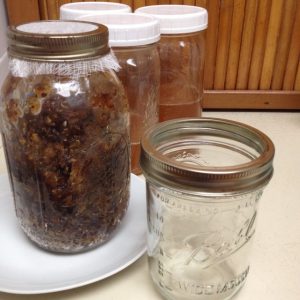
But then I got the brilliant idea of using both a wide mouth and a narrow mouth mason jar. It turns out that, even with both bands screwed on, the opening of a narrow mouth mason jar fits nicely inside the opening of a wide mouth mason jar. I put crushed comb into a narrow mouth quart mason jar, draped cheesecloth over the opening and screwed on the band. I then put a wide mouth pint mason jar with its band, but no cheesecloth, over the top of the quart jar and flipped the pair over. I still duct taped the pair together, mainly to prevent insects from crawling into any opening.
No more leaking!
I’m finding, however, that the straining is taking a very long time, days and days instead of the promised hours in the instructions. Perhaps my house isn’t warm enough. Perhaps the honey is a bit crystallized after being outside all winter long.
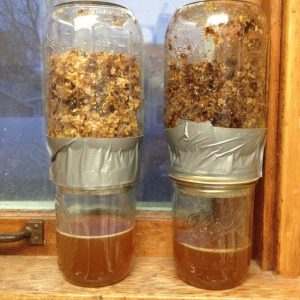 Nonetheless, slowly and surely, thick droplets of honey are filtering down into my honey jars. My anticipation builds.
Nonetheless, slowly and surely, thick droplets of honey are filtering down into my honey jars. My anticipation builds.
Meanwhile, I’ve ordered another package of bees for this spring. They should arrive at the end of April.
And now I know what I will do the next time I want to get honey from my hives.
D’Ni Tame Cat
 Today, January 7, is the anniversary of the date D’Ni Wild Cat became a house cat.
Today, January 7, is the anniversary of the date D’Ni Wild Cat became a house cat.
The year was 2001. We were out in our back yard when we spotted her – a little black furry thing hiding under the asparagus. At first we thought soft furry Duncan had gotten out – but this cat was smaller. And much more scared. We named her D’Ni: a name starting with a “D” because she looked so much like Duncan; and D’Ni after the people inhabiting our favorite computer games, Myst and Riven.
That fall it became apparent to us that D’Ni was pregnant. Being the cat–loving people we were, we started feeding her. Her favorite hiding spot at that time was under all the flowers next to the fence. That’s where I took her food.
One Sunday morning in September we heard pathetic meows coming from the neighbor’s garage. No one next door was yet awake so I went over there and tentatively tried the door. It was unlocked. The minute I opened the door a small furry black bullet flew off the rafters, shot through the door, and raced away to the house two doors down. For the remainder of the day we heard the plaintive heartrending cries of a mama cat that had lost her kittens. We never found out what happened to the kittens. Did the kittens die because she got shut in the garage and was not able to feed them? We only knew that little black cat was no longer pregnant, but no kittens were ever found.
 We still fed her. Pete, despite saying he did not encourage such behavior (that is – feeding a stray, feral cat), began, instead, feeding her on the back porch.
We still fed her. Pete, despite saying he did not encourage such behavior (that is – feeding a stray, feral cat), began, instead, feeding her on the back porch.
And so began the experiment. Was it possible to tame a feral cat?
We held out our hands to her. By November she began sniffing them.
The weather outside was getting cold. We lined a cardboard box with soft towels. The winds were getting chilly. We took a hard–sided cat carrier out to the back porch, lined it with blankets, wrapped it in an old down coat.
At the beginning of December, all thoughts of kittens gone, D’Ni went into heat. Cats from all over Goshen began showing up in our back yard as we tried, unsuccessfully, to catch her. She was wild; she did not trust humans, and she was fast. The moment she heard us approach the back porch she was out of the crate and running away. We were getting very anxious – December is no time to have kittens.
On Christmas Eve, we were making breakfast – eggs, bacon, toast. We were still in our pajamas. I stepped outside to check on D’Ni. She was in the crate. I crouched down. She stayed in the crate. I slammed the crate door shut and she exploded. All thoughts of breakfast forgotten, we threw on some clothes and took crate and the enclosed struggling wild animal off to the vet. A few weeks earlier, I had already warned them that we were caring for a feral cat and that, whenever we could catch her, we would bring her in to be spayed. It was time.
When we picked her up a couple of days later, the deed done, her chart was coded “feral cat”. I had warned them. But perhaps they did not take me seriously. Apparently the kid taking care of the kennels had opened up her cage and she flew out, claws outstretched. They had to catch her with a net.
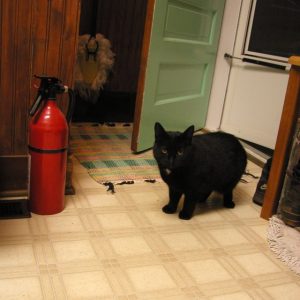 All winter we fed her outside, attracting raccoons and opposums to our back porch as well. We started trying to feed her in the kitchen. We closed off the kitchen from the rest of the house, opened up the back door, and coaxed her in. She started eating right by the back door, then further in. But we couldn’t close the door behind her. So we would stay there, shivering, until she was fled back outdoors.
All winter we fed her outside, attracting raccoons and opposums to our back porch as well. We started trying to feed her in the kitchen. We closed off the kitchen from the rest of the house, opened up the back door, and coaxed her in. She started eating right by the back door, then further in. But we couldn’t close the door behind her. So we would stay there, shivering, until she was fled back outdoors.
When summer came, D’Ni became bolder. At feeding times, we opened up the door between the kitchen and the rest of the house. One day she rushed into the living room, grabbed a toy, and rushed back outdoors. It was great to see her actually playing instead of always hiding and running away.
By the next winter, she was regularly eating in the kitchen, though she still did not want the outside door shut.
Finally, in January, 2003, we decided to try to keep her inside. At dinner time, she came in as usual. We fed her, then shut her inside.
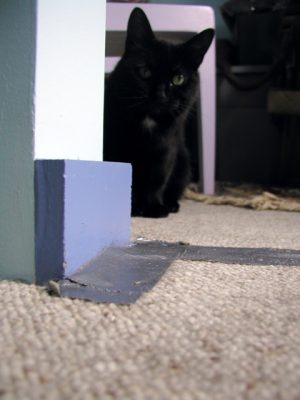 Oh the howling that ensued! For hours she howled. We went to bed and buried our heads in our pillows while she howled some more. Finally at 3:30am, unable to sleep, unable to stand the noise any more, we let her go back outside. The next day, we tried again. More howling, then silent resignation. She was so frightened that she became totally pliable. We could pick her up, carry her, snuggle her, and she did not struggle.
Oh the howling that ensued! For hours she howled. We went to bed and buried our heads in our pillows while she howled some more. Finally at 3:30am, unable to sleep, unable to stand the noise any more, we let her go back outside. The next day, we tried again. More howling, then silent resignation. She was so frightened that she became totally pliable. We could pick her up, carry her, snuggle her, and she did not struggle.
As she became more accustomed to the house, her wild habits came back. There was no more picking up and snuggling. She now knew where to run and hide. Claws out, she twisted out of our grasps and fled to her hiding spots.
But she got used to being indoors. And then she never really wanted to go back outside again. As the years have gone by, she became more and more tame. Now we can pick her up and even trim her claws. Now she loves climbing on Pete’s lap to sleep while he watches movies.
No more D’Ni Wild Cat. Now it is D’Ni Tame Cat.
List after List: The January Ritual of Deciding What Seeds to Order
It’s January, and that means that I am starting to get new seed catalogs. There isn’t much to do outside in the garden this time of the year, which makes it a perfect time to start planning what I want to plant in the spring.
I do most of my ordering online, but I do most of my seed selection through those paper catalogs that come in the mail. I spend hours poring over my favorite catalogs.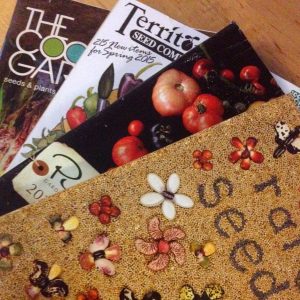
My new very favorite catalog is from Baker Creek Heirloom Seed Company. This catalog meets my criteria of having a great selection of heirloom and organic seeds and being aesthetically pleasing. But, in addition, it features quirky photographs of Baker Creek employees in wonderfully weird poses with vegetables. The catalog makes me smile every time I open it. It also makes me want to work there, except for the fact that I really don’t want to live in Missouri. Everyone looks like they are having so much fun!
As the winter progresses, my stack of favorite catalogs continues to clutter up the dining room table.
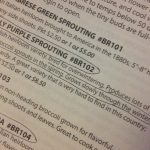 I peruse each page of each seed catalog armed with pen, highlighter, and sticky notes. I circle and star those seeds that I am interested in and highlight features that catch my attention: “bred for overwintering”, “frost hardy”, “an excellent keeping variety”, “dating back to 1880”, “grown from seed provided by our Belorussian friend”, “good disease resistance”, “takes the heat and keeps producing all summer”, “easy to grow”, “very unique”, “high in vitamin C”. As usual, I’m drawn the unusual: Oaxacan Green Corn, Blue Tomatoes, Scarlet Kale. Emmer Wheat. Turkish Orange Eggplant. Sticky notes go on pages that I particularly want to go back to.
I peruse each page of each seed catalog armed with pen, highlighter, and sticky notes. I circle and star those seeds that I am interested in and highlight features that catch my attention: “bred for overwintering”, “frost hardy”, “an excellent keeping variety”, “dating back to 1880”, “grown from seed provided by our Belorussian friend”, “good disease resistance”, “takes the heat and keeps producing all summer”, “easy to grow”, “very unique”, “high in vitamin C”. As usual, I’m drawn the unusual: Oaxacan Green Corn, Blue Tomatoes, Scarlet Kale. Emmer Wheat. Turkish Orange Eggplant. Sticky notes go on pages that I particularly want to go back to.
In this first run through a catalog, I select anything and everything that looks interesting to me – much more than would ever fit in my garden. This first perusal is my time to be expansive and to dream big.
Eventually, though, reality hits. Even though I do have a large garden, it is not infinitely large. And my budget will not permit me to get everything that I have marked. So my second run through the catalog is a time to refine my selections. This is the time that I go through the catalog again, page by page. This is the time to start making lists. Until I make a list, I have no idea how many things have piqued my interest. Have I selected 20 seed packets or 200 seed packets? With random markings scattered in several 100–200 page catalogs, I have no way of knowing how expansive I’ve been.
 Now with my gardening journal and the seed catalogs next to me, I start writing down the list of seeds I want to purchase. Sometimes I have to make choices within a category: only one variety of carrot; only one variety of green bean, actually make that two varieties – one bush and one pole; lettuce – one mix suitable for hot weather and one mix suitable for cold weather. For each item in my list, I note from which catalog and on which page number that item can be found. The list can be long, usually is long, usually still too long. I still need to pare it down.
Now with my gardening journal and the seed catalogs next to me, I start writing down the list of seeds I want to purchase. Sometimes I have to make choices within a category: only one variety of carrot; only one variety of green bean, actually make that two varieties – one bush and one pole; lettuce – one mix suitable for hot weather and one mix suitable for cold weather. For each item in my list, I note from which catalog and on which page number that item can be found. The list can be long, usually is long, usually still too long. I still need to pare it down.
At this point in the process, I make a second list – the list of seeds that I have left over from the previous year.
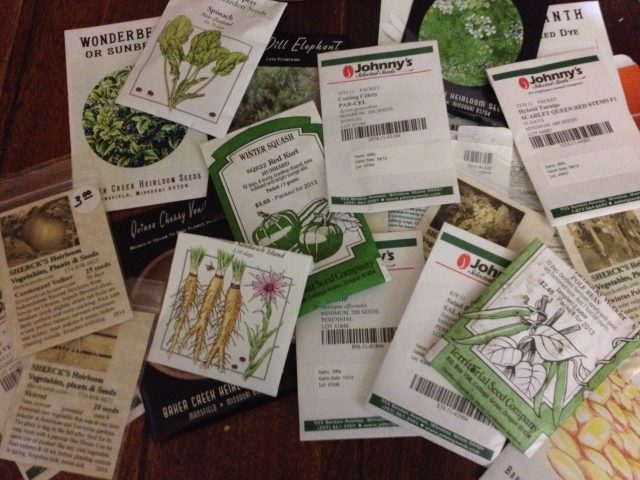
I keep my seeds in the basement, in my canning pantry, where it is cool. I bring the box with seed packets upstairs and begin cataloguing the seeds I have. Then, looking at both lists, the “I have” list and the “I want” list) I make yet a third list, the “I still need” list. By the end of this process, I have a much more manageable list.
The final step in the process is looking at the cost. Now I write down the prices for all those packets on my “I still need” list and bring out my calculator. Horseradish root? Too expensive. Purple tomatillos? Maybe I’ll wait on that – after all, the regular green tomatillos will undoubtedly have reseeded themselves (they usually do). Eventually I have narrowed my selections down. To spread the love around, I often buy from 3–4 seed providers. I make up clean, easy to read lists of what I am ordering, go to my computer, and begin the actual buying.
Coming next month: In February, when my seed packets start arriving, I will look at my seeds and my garden plans, and start planning where I will plant those seeds.
The Aesthetics of Seed Catalogs
Seed catalogs are arriving in my mailbox almost daily now. Some go directly into the recycling. Some go into the basket of magazines and catalogs near the door for perusal at a later time. Some come into the house with me for immediate consideration.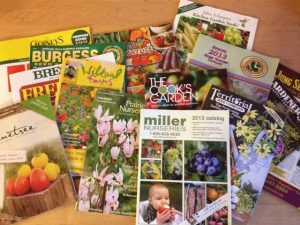
What differentiates these catalogs is not the content (though I do tend to favor organic and heirloom seeds over the conventional variety). What differentiates these catalogs is their aesthetics.
First there is the size. Seed catalogs come in all sorts of sizes. The catalogs that are in large tabloid sizing go immediately into the recycling. That size is just too cumbersome. They are hard to hold. I can’t easily sit in bed or in a comfy chair and pore over each page. The bottom crinkles on my lap and gets creases in weird places unless I hold the catalog higher, but then my arms get tired. It is just not worth the bother. So into the recycling they go.
The other sizes are much more manageable. There is the traditional magazine size, which is reasonable to handle. Then there is a smaller size – a bit taller than a paperback, but not much wider. All these catalogs deserve a look.
Once I have determined that a catalog is worth looking at, I open it. Now comes the next differentiating criterion: the layout of the interior pages. Some catalogs are crammed full of little pictures of plants on each page. Accompanying the barrage of little pictures is the tiny font that describes the seeds. When I look at such pages there is an overload of information. I have to strain to read the type. I get agitated. I cannot relax and enjoy the experience of savoring each page. Into the recycling they go.
Often associated with the amount of information on each page is the amount of color on each page. Sometimes the colors are much too bright. Sometimes there are just too many colors crammed together on a single page. I much prefer more muted colors and a more coherent color scheme. So if the colors in a catalog disturb me, into the recycling it goes.
Some catalogs try to catch your attention by highlighting certain seeds as award winners or the catalog “choice.” All those extra icons and symbols make the pages look messy. I particularly dislike those catalogs that are alarmist in nature and pronounce that this will be your “last chance” to purchase some seed variety. Really? It will be my last chance ever? Are those seeds going extinct? Into the recycling these catalogs go.
So now I have pared down my selection of catalogs: they are of a reasonable size, and they have a reasonable number of selections of seeds on each page and a soothing color scheme. Now come some finer distinctions.
Catalogs are printed on different types of paper. Most of them are printed on glossy magazine paper. Some are printed on rough, grayish newsprint paper. I must say that I do prefer either white paper or glossy paper, though I feel that I should like the newsprint best. (Is newsprint more biodegradable?) Though I have a preference for the type of paper, I don’t dismiss any catalog simply on that basis.
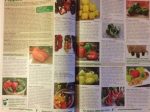
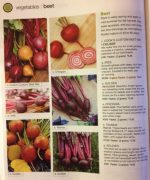 Some catalogs have text boxes that discuss planting tips and germination times in addition to the description of the seeds that they sell. This is all helpful information. My estimation of those catalogs rises.
Some catalogs have text boxes that discuss planting tips and germination times in addition to the description of the seeds that they sell. This is all helpful information. My estimation of those catalogs rises.
So, you may be wondering by now what is my favorite catalog. I am not sure that I can answer that. There are several catalogs that I enjoy perusing and from which I purchase seeds.
However, if I were to select a catalog for purely aesthetic reasons, there is one catalog that stands out above the rest.This catalog is magazine sized, with just a few seed selections on each page. The color scheme is very muted. In fact, many of the pages are just charcoal print on white paper with dusty green headings. The paper is white but not glossy, heavier than regular laser-print paper, but not as heavy as cardstock. And there are no photos at all. Instead, there are drawings, some in color, some just in that dusty green color.
Even though this catalog is not packed with seed selections, it gives me the impression that the seeds that are offered have been carefully chosen. The presentation is beautiful. I’ve already started starring those seeds I am interested in getting. And I am sure that I will look at this catalog, John Scheepers Kitchen Garden Seeds, over and over again.
Nuts for Research
The Arbor Day Foundation Hazelnut Project collaborates with members to develop sustainable strains of hybrid hazelnut plants.
I love hazelnuts. Since childhood, they have been one of my favorite nuts. So, of course, I wanted to plant some hazelnut bushes as part of my fruit and nut micro–orchard. Then I discovered that, not only could I get little starts from The Arbor Day Foundation, I could participate in their hazelnut research project at the same time.
The Arbor Day Foundation is involved in research toward developing strains of hybrid hazelnuts to be used for food, livestock feed, and bio–energy. Their goal is to breed high yielding hazelnuts that can be grown in a variety of settings, soils, and locations. For a donation of $20, anyone can become a member of The Hazelnut Project, get three hazelnut seedlings, receive periodic updates on the research project, and be a research participant by annually reporting how the hazelnut bushes are doing.
In 2012, I received my first three hazelnuts seedlings. My seedlings arrived in late May right at the start of that year’s summer drought. Sadly, my seedlings did not make it. This spring I received three replacement seedlings. I also planted three additional Arbor Day Foundation seedlings that I got from a friend. All six did well for a few weeks, growing and sprouting new leaves, but then, on some of the seedlings, the leaves began shriveling up and dying. Other seedlings looked like they had become a meal for the wild rabbits that live in my garden. Fortunately, and rather surprisingly, four of the six recovered and small leaves emerged from the tiny remaining stems. Once I saw these little leaves, I quickly put up some rabbit fencing around the tiny plants to mark them and protect them from the hungry rabbits. Over the course of the summer, I watched my little seedlings, watering them when they needed it, weeding and mulching around them. The seedlings are still very small, only a fews inches tall, and the leaves are starting to turn in preparation for winter’s dormancy. I do hope they make it through the winter. If not, I’m sure I will try again next spring.
A few days ago I received my annual survey to report on my seedlings’ progress. There were questions about the survival rate of the seedlings and about the nut production of any larger bushes from prior years. Since this is the first year for my little plants, I wrote about what I observed and what had occurred.
It’s fun to be able to participate in this research project to promote and develop food crops such as these hazelnuts. I love growing food crops and it is gratifying to also be able to contribute to a larger endeavor.
